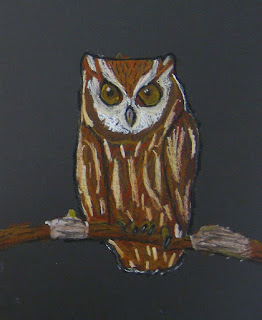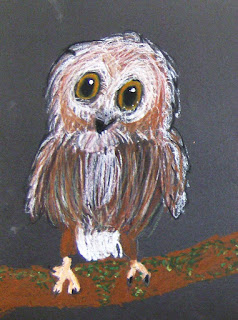 To create these amazing owls, you will need a set of oil pastels (24 or 36 is best), black construction paper (9 x 12), a pencil, a small easel, and a good color photo of an owl. We have files of resource pictures at the art center, including one of just owls. Most of our resource photos are collected from old calendars or nature magazines. Optional materials are masking tape, tracing paper and carbon paper.
To create these amazing owls, you will need a set of oil pastels (24 or 36 is best), black construction paper (9 x 12), a pencil, a small easel, and a good color photo of an owl. We have files of resource pictures at the art center, including one of just owls. Most of our resource photos are collected from old calendars or nature magazines. Optional materials are masking tape, tracing paper and carbon paper.First, select the photo of an owl you would like to use for your model. If the owl is large enough to trace and transfer to the art paper, I don't have any problem with that. Why? Because I consider this to be a lesson in oil pastel techniques, so I don't want the student to stress over or get hung up on the drawing part. We just want the image on the paper so we can begin play with the oil pastels!
Observing the owl model carefully (which should be displayed on the easel), the student draws it in pencil on the black paper, being carefully to center it and not make it too small. The owl (and a portion of whatever it is perched on) should fill the paper. If the student would rather transfer the owl image to the artwork, they will trace the basic shape of the owl on the tracing paper. They need to include only the major features such as the eyes, the beak, the talons, and any stark divisions in color (such as white areas to black areas). They should not try to draw every feather or detail. The image is then placed over the black paper with the carbon paper (shiny side up) sandwiched between. Use masking tape to tape down the "sandwich" at two or three corners so nothing moves around while transferring the image by drawing over the same pencil lines again. (You can lift a corner now and again to be sure the entire image has been traced.) Remove the carbon and tracing papers.
 Now the student will create a palette for his or her owl art. One by one, select the oil pastels that might match the colors in your owl and hold them up to the photo. If you see that color anywhere in the photo, set it aside. This pastel stick becomes part of your palette. Continue until you have your complete palette, making sure you have included black and white. Keep these pastels separate until you have finished your art work.
Now the student will create a palette for his or her owl art. One by one, select the oil pastels that might match the colors in your owl and hold them up to the photo. If you see that color anywhere in the photo, set it aside. This pastel stick becomes part of your palette. Continue until you have your complete palette, making sure you have included black and white. Keep these pastels separate until you have finished your art work.We always begin with the eyes. Fill in the iris color (pressing firmly) and perhaps add a second similar color on top. Oil pastels mix beautifully when layered! Repeat with the other eye. Now add the pupils in black, and the black surrounding the eyes (look carefully at the photo to get the correct shape). When you are done, add a bright white spot somewhere in one eye (maybe upper right side of the pupil) then again in the other eye, same spot.
WOW! The eyes take on such an "alive" appearance, the rest of the owl seems easy. Just work your way out from the eyes, using strokes that imitate the growth of the feathers. In other words, don't stroke left to right if the feathers grow vertically. Use darker colors first, then highlight with lighter colors and white.
This project is a great introduction to serious oil pastel painting - we just love them! Oil pastels are especially suited to bird and animal portraits on black paper. Start with the eyes!

No comments:
Post a Comment